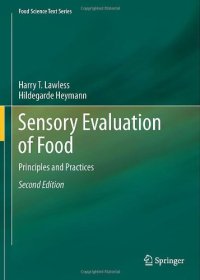
Ebook: Sensory Evaluation of Food: Principles and Practices
- Tags: Food Science, Neurochemistry, Receptors
- Series: Food Science Text Series
- Year: 2010
- Publisher: Springer-Verlag New York
- Edition: 2
- Language: English
- pdf
The field of sensory science has grown exponentially since the publication of the first edition of Sensory Evaluation of Food. Fifteen years ago, the journal Food Quality and Preference was fairly new. Now it holds an eminent position as a venue for research on sensory test methods (among many other topics). Knowledge of the intricate cellular processes in chemoreception, as well as their genetic basis has undergone nothing less than a revolution, culminating in the award of the Nobel Prize to Buck and Axel in 2004 for their discovery of the olfactory receptor gene super family. Advances in statistical methodology have accelerated as well. Sensometrics meetings are now vigorous and well-attended annual events. And yet, some things stay the same. Sensory testing will always involve human participants. But humans are tough measuring instruments to work with. They come with varying degrees of acumen, training, experiences, differing genetic equipment, sensory capabilities, and of course, different preferences. Human foibles and their associated error variance will continue to place a limitation on sensory tests and actionable results.
Although methods continue to evolve, appreciation of the core principles of the field is the key to effective application of sensory test methods. This book has been expanded to reflect the advances in methodologies, theory, and analysis that have transpired in the last 15 years. The chapters are now divided into numbered subsections. This may be of assistance to educators who may wish to assign only certain critical sections to beginning students. In some of the opening sections instructors will find suggestions about which sections are key for fundamental understanding of that topic or method. In many chapters we have gone out on a limb and specified a “recommended procedure.” In cases where there are multiple options for procedure or analysis, we usually chose a simple solution over one that is more complex.
This text attempts to be comprehensive, yet understandable to all students at the university level. All the major sensory test methods are illustrated and discussed, including discrimination, descriptive, and affective tests. Some chapters are devoted to special topics, such as thresholds, time-intensity methods, similarity testing, color, texture, sensory quality control, qualitative research methods, consumer test methods and questionnaires, shelf life testing, an introduction to multivariate statistical techniques, and strategic sensory research. The statistical appendix provides basic instruction in the common statistical analyses for sensory evaluation with worked examples.
Harry T. Lawless is Professor of Food Science at Cornell University where he teaches sensory evaluation. He has 35 years of experience in chemosensory research and psychophysics. He spent five years in consumer testing in industry, and serves as a consultant to various food and consumer products companies on sensory test methods.
Hildegarde Heymann is Professor of Viticulture and Enology at the University of California at Davis where she teaches sensory evaluation of wine and sensometrics. She spent nearly 17 years at the University of Missouri as a professor of sensory science.
This volume covers all the basic techniques of sensory testing, from simple discrimination tests to home use placements for consumers. It provides fundamental theories, psychological and statistical, that form the basis and rationale for sensory test design. Statistics used in sensory evaluation are also demonstrated both as stand-alone material presented in appendices and as integrated applications in the context of appropriate sensory methods. Chapters are constructed so that beginning students who want only the practical aspects of conducting sensory test will see clear instruction on how test should be conducted. Advanced students and practitioners will enjoy the more detailed sections on rationale and related issues.